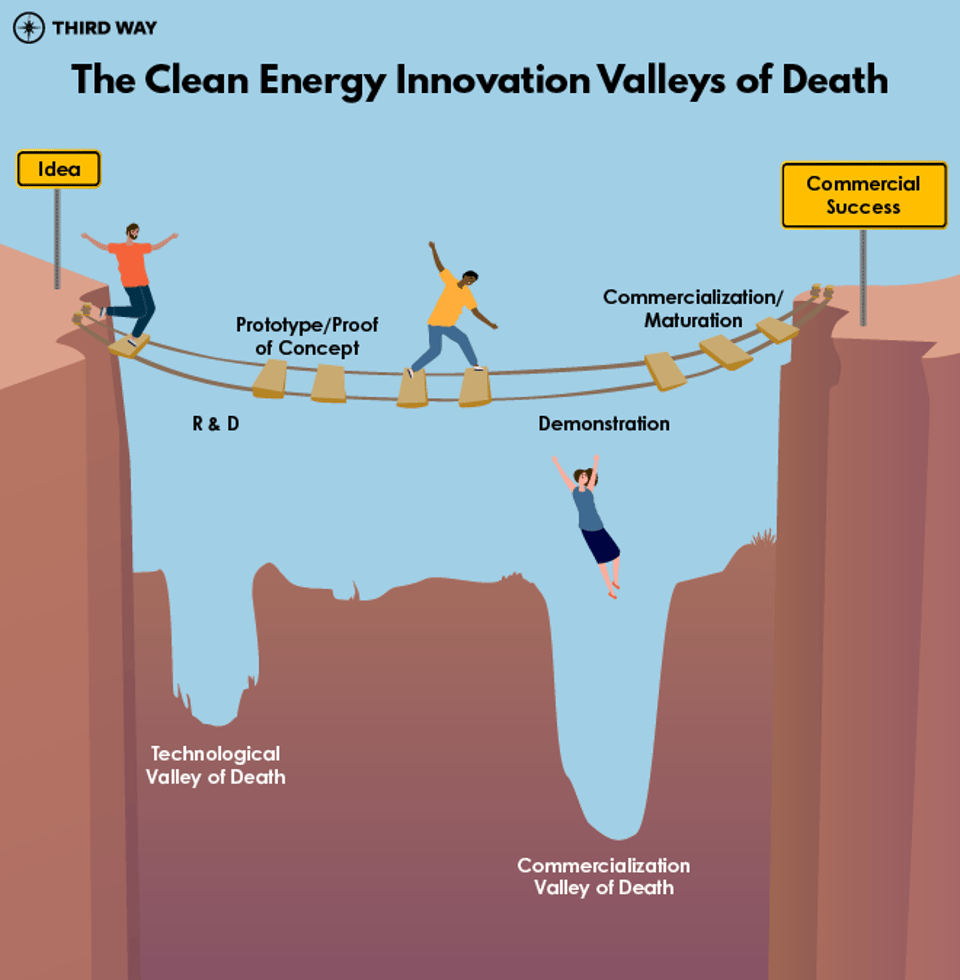Memo Published July 27, 2020 · 13 minute read
Clean Energy Demonstration Projects: Critical for Economic Recovery and Mitigating Climate Change
Farah Benahmed & Elizabeth Noll

Takeaways
- Investing in clean energy demonstrations would deliver near-term job creation and opportunity, long-term economic growth, and innovative solutions necessary to meeting our mid-century climate goals.
- The federal government must invest now in clean energy demonstrations to accelerate innovation and rapidly bring these technologies to market.
- In future economic recovery bills, Congress should appropriate funds to the Department of Energy to oversee and complete the clean energy demonstration projects that are able to get started quickly.
The United States is dealing with an onslaught of crises all at once: the COVID-19 public health crisis; the largest economic crisis since the Great Depression; and a climate crisis presenting one of the greatest challenges in human history. Even if we strengthen our efforts to control the pandemic and begin a return to normal operations, economists expect the country to see stubborn unemployment, low consumer confidence, and lost momentum in previously growing industries.1
The ongoing challenges of the climate and economic crises cannot rest completely on the shoulders of a weakened private sector. The federal government must take bold, immediate, comprehensive action to stimulate long-term economic growth and increase our resilience by scaling investment in clean energy businesses, entrepreneurs, and infrastructure. Policymakers can aggressively grow jobs and kickstart new markets by encouraging clean energy innovation and deployment.
While our nation is renowned for its world-class energy technology research at US national laboratories and universities, the federal dollars often evaporate during the later stages of energy technology development. This hurdle, sometimes called the “second valley of death”, leaves many innovative entrepreneurs and small businesses at risk of failure, closing opportunities to create lucrative new energy markets and stalling the development of critical technologies for fighting climate change. We must expand and strengthen federal clean energy innovation programs to stop this trend and make America more resilient in the face of the challenges it must confront.2
This memo focuses on the biggest opportunity area in innovation—the demonstration phase. It highlights the economic benefits of investing in clean energy demonstration projects and discusses the need for immediate action. Finally, the memo describes the clean energy technologies that, with federal support for demonstrations, could generate major economic and emissions benefits in the near- and long-term.
Demonstration Projects Can Aid America’s Recovery
Investing in clean energy technology demonstrations is an effective way to jumpstart the economic recovery while advancing the technology solutions we require to reach our long-term climate goals. Demonstrations help identify system-level challenges, pinpoint opportunities for cost reduction, and validate the maturity of a technology. In some cases, jobs created by demonstrations of emerging technologies would be very well-suited for underutilized workers in struggling fields. For instance, skills from oil and gas drilling are directly transferable to the advanced geothermal sector, creating a pathway for workers to apply their skills to a job-rich and rapidly growing clean energy sector.
Technology demonstrations reduce the time to market for more efficient, cleaner technologies, which can give US companies a competitive advantage in the global marketplace. Federal and state policy assistance for renewable energy has helped catalyze a robust and expanding industry. Wind and solar costs have declined 10-fold over the last 10 years,3 and the positions associated with these technologies (e.g.,wind technicians and solar installers) were the fastest growing of any industry in the country up until the pandemic.4
The commercialization of renewable energy is putting people to work, making clean energy affordable, and reducing emissions in the power sector. The same is true for energy storage. Since the first lithium-ion battery was commercialized in 1991, investments have been made to consistently improve battery technology, leading to record levels of growth in energy storage. The global market for storage technologies is now projected to expand 13-fold by 2024. The United States, which maintains 34% of deployed capacity, is the clear frontrunner.5
Policymakers should replicate this success for technology solutions in lagging sectors like transportation, manufacturing, and industry. A recent report from the International Energy Agency finds that three-quarters of the cumulative emissions reductions necessary to avoid the worst impacts of climate change will depend on technologies in early stages of development that need assistance in quickly getting to market.6 Testing, validating, and scaling these early-stage technologies, like carbon capture, use, and storage (CCUS) for industrial processes and low-carbon hydrogen fuel for marine transport and energy storage will make it possible to get all the way to net-zero. It also gives the companies and countries that develop these technologies an edge in capturing markets in Europe, Asia, and other areas of the world clamoring for low-carbon solutions and could create new opportunities to license, construct, manufacture, and supply components for these innovations around the world.7
Success Stories: Demonstrating Off-Shore Wind & Carbon Capture
The federal government has recently overseen successful clean energy demonstration projects, offering best practices that policymakers should adopt to scale demonstrations of other vital technology applications.
Offshore Wind
The offshore wind industry is estimated to create 83,000 jobs and deliver $25 billion annually to the US economy within the next decade.8 But this fast-growing industry didn’t mature on its own. In an effort to build a robust domestic offshore wind industry, the federal government has provided over $200 million for research, development, and demonstration projects, and that investment has paid off.9 The Lake Erie Energy Development Corporation’s (LEEDCo) Icebreaker project is one of many offshore wind demonstration projects DOE has supported.10 Beginning with a $40 million award from DOE in 2016, the project should reach commercial operation by the end of 2022, assuming it can overcome remaining regulatory hurdles.11 It would be the first offshore wind facility in the Great Lakes, aiming to bring 8,000 jobs and cleaner air and water to the region.12
Carbon Capture
The Petra Nova Carbon Capture Project kicked off with a $167 million DOE award in 2010 to demonstrate carbon capture technology at a coal-fired power plant near Houston, Texas.13 Like most large-scale demonstration projects, testing and efforts to scale Petra Nova created some unexpected cost overruns. While DOE helped with a small fraction of the additional costs, the plant’s ability to attract new partners showcased the credibility and promise of the project, made possible by DOE’s initial award.14 Petra Nova went online in 2017, creating the world’s largest carbon capture facility, reducing 90% of carbon pollution from its coal plant, and establishing the technical feasibility of carbon capture retrofits of power plants.
Now is the Time for America to Invest in Demonstrations
The United States could be far more successful in helping clean energy technologies get across the finish line and into commercial markets.15 Today, clean energy researchers and entrepreneurs face an innovation gap, struggling to secure either private sector investment or federal funding for their technology demonstration projects, leaving economically viable solutions behind.16
Given the uncertainty and scale of investment involved, the private sector is generally unwilling to take risks in this area until the technologies are derisked by the government and economic returns are assured. Demonstrations can provide the assurance and validation needed to attract investors and bring a technology to market, overcoming the second valley of death.

Demonstrations are most often a partnership between industry and the federal government, where both parties have an interest in the success of a project. However, with the economy in disarray from the global pandemic, it’s more challenging for businesses to secure private capital. Without government support for demonstrations, only a tiny fraction of promising new technologies have a chance of reaching commercialization.17 The federal government should significantly increase its investment in clean energy demonstration projects while temporarily reducing the amount the developer must contribute through what is often referred to as the non-federal “cost share.” Congress should start by investing in the following types of clean energy demonstrations that could quickly receive funding through DOE and start making an economic impact in the near future:
Advanced Nuclear
Advanced nuclear energy is an important technology for decarbonization. It’s flexible and dispatchable, has extraordinarily high energy density, and can generate both power and emissions-free heat that could replace fossil fuels in manufacturing processes.
Successful advanced reactor demonstrations have the potential to reinvigorate the nuclear energy industry, create jobs, and reduce emissions. Today, there are dozens of advanced reactor start-up companies in the United States looking to get ahead of their international competitors.18 Commercializing and exporting new American reactors will bolster our global competitiveness, national security, and leadership on climate.
Congress should authorize and provide additional funding for the Advanced Reactor Demonstration Program to demonstrate two advanced nuclear reactors by 2025.19 This program was initiated with a $230 million appropriation in fiscal year 2020.20 Teams of reactor developers, manufacturers, utilities, and others are already forming to apply for funding. In addition to these demonstrations, the program provides Risk Reduction for Future Demonstration awards for 2-5 unique advanced reactor designs that could be commercialized by 2030, making sure the innovation pipeline stays full and the United States can take advantage of a wider range of technologies. Congress should commit at least the same level of investment in the program each year through 2025 to enable recipients to expand their operations. Committees in both the Senate and House have cleared legislation authorizing these demonstrations with bipartisan support.
Renewable Energy
We are seeing the payoff from nearly 40 years of federally funded research and development of renewable technology. Government research has fostered innovations in wind technology, such as taller turbines and bigger blades, to generate more energy. In the last decade we’ve seen the cost of onshore wind and solar fall from around $100 per MWh and $300 per MWh, respectively, to less than $30 per MWh, making them cost competitive with fossil fuels.21 Over the past five years, employment in the clean energy industry has grown 70 percent faster than the economy overall.22
However, accelerated expansion of renewable energy and continued innovation are essential to reaching our ambitious emissions reduction goals. Federal support to demonstrate and validate new cost-competitive renewable energy technologies will improve efficiency, resilience, capacity, materials and manufacturing, while continuing to drive down costs.23
One promising clean energy technology ready for immediate federal investment through large-scale demonstration is enhanced geothermal systems (EGS). EGS utilizes drilling and production techniques similar to the oil and gas industry to reach deeper and hotter rocks, and the necessary skills are directly transferable from one industry to the other. Expanding EGS could provide opportunities for collaboration with the oil and gas industry and would support the transition of the struggling oil and gas workforce to less volatile, expanding clean energy sectors. Additionally, leveraging the knowledge and expertise of the oil and gas industry could spur greater innovation to reach gigawatts of geothermal resources in a much greater swath of the country than are accessible today.24
Congress should authorize and invest $150 million to build four enhanced geothermal system demonstrations.25 The DOE should prioritize demonstrations based on specific regional needs. These EGS demonstrations can target electricity generation, heating and cooling systems, and other direct geothermal applications. This funding should build on existing work within DOE’s Geothermal Technologies Office (GTO), which is well-connected to industry, universities, national laboratories, and other experts that can help scale the technology.
Energy Storage
Energy storage technologies can help balance supply and demand in the power grid and improve energy quality and delivery. They’re also an important job creator, supporting about 75,000 jobs in the United States in 2019 and enabling another 64,000 jobs in grid modernization.26 But the industry is nowhere near its full technical and economic potential.
Demand for electricity storage will only continue to grow as countries try to deploy additional cheap, variable renewables onto the grid. Most current energy storage technologies come in the form of lithium-ion batteries, which aren’t well equipped to handle the long-duration (monthly or seasonal) energy storage needs of grids with a large proportion of renewables. By supporting demonstrations of emerging technologies like flow batteries and modular pumped storage, the federal government can help advance US energy storage industries and help American businesses capture more of the expanding global market for these products.
Congress should authorize and invest $1 billion into commercial energy storage demonstrations, with a goal of five or more commercial demonstrations of different technologies by 2025. This should build on existing energy storage programs within DOE’s Office of Electricity Delivery and Energy Reliability (OE) and Office of Energy Efficiency and Renewable Energy (EERE), as well as the Energy Storage Grand Challenge currently under development.27 Congress can leverage the authorization developed in the American Energy Innovation Act and related legislation to expand funding for important cross-sector, multi-technology energy storage projects.28
Clean Hydrogen
Hydrogen and fuel cells have the potential to significantly reduce carbon emissions from multiple sectors, including power, transportation, buildings, and industry.29 With its wide range of applications, hydrogen can tackle difficult-to-decarbonize industries and help the US economy attain net-zero emissions. Realizing hydrogen’s potential will also build a diverse set of jobs in a fast-growing industry.
Congress should provide $1 billion for multiple hydrogen demonstration projects. These demonstrations should, at a minimum, target industries such as, heavy-duty land and marine transportation, heat and power applications in buildings, port operations, power sector use cases, ammonia production, and iron/steel manufacturing. The funding should build on DOE’s existing programs and partnerships with the national labs.30
Carbon Capture, Use, and Storage
Beyond reducing emissions at power plants, CCUS is also one of the few technologies that can address emissions from industrial processes like the production of steel, cement, and chemicals. The industrial sector is the third-largest source of global emissions, behind transportation and power, and is widely seen as the hardest of the three to abate. With decarbonization solutions hard to come by, the companies that commercialize these game-changing technologies will be well-positioned to take advantage of global demand for low-carbon manufacturing in the future. Negative emissions technologies like direct air capture (DAC) must also play a major role in reducing concentrations of carbon dioxide in the atmosphere, but this industry has yet to take off.31 The United States can tap into these environmental and economic opportunities by supporting demonstrations of CCUS in vital new applications.
Congress should provide $3 billion for demonstrations of CCUS technology at natural gas power plants and DAC facilities. These should include no fewer than two natural gas facilities and one direct air capture facility.32 With the passage of the American Recovery and Reinvestment Act (ARRA), DOE successfully funded a handful of large-scale CCUS projects. However, there are still no commercial-scale natural gas power plants with CCUS in the United States, nor are there any large-scale DAC facilities.33 Recent federal R&D investments are supporting three front-end engineering and design (FEED) awardees to assess CCUS technologies on natural gas facilities. These projects would be well-positioned to scale up to the demonstration phase if they receive federal support.34
Congress should provide $3 billion for large-scale CCUS demonstration projects at industrial facilities. Lawmakers previously authorized DOE to provide up to $200 million in awards each year to large-scale industrial carbon capture projects.35 Under ARRA, DOE successfully funded the Archer Daniels Midland plant in Decatur, Illinois, which applied integrated, onsite carbon capture and storage at an ethanol facility for the first time. Many sectors could benefit from federal support for carbon capture technology, from ethanol and natural gas processes to cement and petrochemical facilities. There are at least seven large-scale industrial carbon capture projects in the planning phase that could be candidates for demonstration funding.36
Conclusion
Congress should prioritize recovery policies that provide major economic returns immediately and over the long-term. Investing in large-scale clean energy demonstration projects won’t just put people to work temporarily—it will generate a return on investment by expanding market opportunities and launching entire industries that employ Americans for decades to come.

